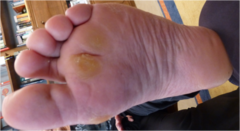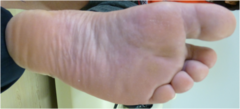Deformities - Injuries
Metatarsalgia
Metatarsalgia occurs in middle-aged women, sometimes along with hallux valgus. It is of unknown aetiology but is correlated with hormonal changes at menopause. The main complaint is pain on the plantar surface of the foot at the site of the metatarsal heads’ protuberance. Callosities under the metatarsal heads is a common finding. Small toes may overlap, be curly, or like a hammer.
There are various insoles on the market that can provide alleviation of pain in early stages, but substantial relief comes only with surgery. Many techniques have been described, all of them having in common combinations of tissue surgery, osteotomies, carried out with fine instruments and potential use of special plates, screws and pins.
Over the last years percutaneous surgical techniques have been developed. Through small holes and with the use of special burrs osteotomies of the metatarsals are performed. No implants are inserted, the foot is draped adequately and the patient walks right after the operation. The advantages of the method are: no damage to the subcutaneous tissues, no visible scars, better healing potential of the osteotomies, no need for potential implant removal later, immediate weight bearing.
This is the method I follow.
Light general or regional anesthesia is used, the latter being preferable.

Προεγχειρητιτικά είναι εμφανείς οι πελματιαίοι τύλοι (κάλοι)

Μετεγχειρητικά οι τύλοι (κάλοι) έχουν εξαφανιστεί